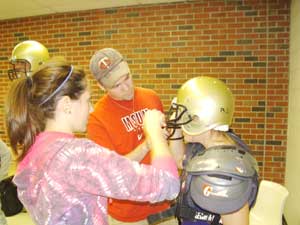Graduation Requirements

- Satisfactorily complete all curricular requirements as stated in the Plan of Study (Plan of study also includes completing a thesis or research project under the supervision of department faculty).
- Students must pass all didactic courses with a 2.0 (C) or better and must pass all clinical education courses with a 3.0 (B) or better
- Students must have a cumulative 3.0 GPA in order to graduate
- Student must accrue a minimum of 1200 clinical hours over the course of the 2 years during their clinical education experience.
- Students must complete and file an Application for Graduation with the Office of Admissions and Records by the specified deadlines. Typically this deadline is the fall semester prior to spring semester graduation
- Students need to be aware of the six year time limit in which all requirements need to be met.
ATP Required Costs
Some costs will be incurred by the athletic training student throughout the program to maintain the appropriate paperwork, retention criteria, etc. Some examples of expenses include but are not limited to: technical standards, background check, immunizations, and any other requirements of an Affiliated Site. The athletic training student is also responsible for other expenses such as but not limited to attire, health insurance and transportation. Students will be accessed a course fee for particular courses in the curriculum.
Accreditation Status
The ATP at Montana State University Billings is currently accredited by the Commission on Accreditation of Athletic Training Education (CAATE) through 2020-21. Current accreditation status does not guarantee the program will receive continuing accreditation status through yearly reports.
Curricular Design
Students enter the AT program with pre-requisite knowledge from undergraduate coursework. The AT program then builds on that pre-requisite knowledge and has a Plan of Study designed to teach the various core content standards throughout the curriculum over the course of two years. We teach patient care from a global perspective or approach, meaning teaching students about the continuum of patient care from prevention, working through evaluation and diagnosis, moving to treatment/management, and the ultimately referral or discharge. We also teach students to approach patient care holistically, where they take into account all facets of patient health (physical, mental, social) into consideration. Throughout the program, AT students have opportunities to engage in experiential learning where they can apply and reinforce skills in their clinical education experiences. Lastly, throughout the curriculum, students are taught and assessed on the knowledge, skills, and abilities required of an entry level professional in athletic training. The ATP curriculum utilizes multimodal methods to teaching including traditional face to face, online, and hybrid courses.
